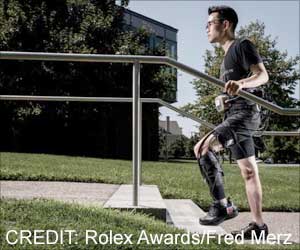
‘ReWalk ReStore exosuit shows positive results for safety, reliability and feasibility in gait rehabilitation for individuals with mobility impairment post-stroke.’
Read More..




The article is published in the Journal of NeuroEngineering and Rehabilitation .Read More..
The ReStore™ exosuit (ReWalk Robotics, Ltd) is the first soft robotic exosuit which has been cleared by the FDA for use in stroke survivors with mobility deficits.
The device is indicated for use in patients with hemiplegia undergoing stroke rehabilitation under the supervision of physical therapists.
Hemiplegia results in weakness of the ankle, limiting the ability to clear the ground during stepping and hindering forward movement. Hemiplegia leads to compensatory walking patterns that increase effort and decrease stability.
ReStore is designed to allow a more normal gait pattern.
Advertisement
This smartphone controller is used by a trained therapist to adjust levels of assistance and monitor and record important metrics of gait training.
Advertisement
The protocol consisted of 5 days of 20-minute sessions of the treadmill and overground training under the supervision of licensed physical therapists.
The therapeutic potential for ReStore in rehabilitation was analyzed by exploring the effects of the device on maximum walking speed, measuring individuals walking speed in and out of the device using a10-m walk test, before and after the five training visits.
For safety purposes, some participants were allowed to use a cane or an AFO during walking sessions.
“We found that the ReStore provided targeted assistance for plantarflexion and dorsiflexion of the paretic ankle, improving the gait pattern,” explained Dr. Nolan.
“This is an important first step toward expanding options for rehabilitative care for the millions of individuals with mobility impairments caused by ischemic and hemorrhagic stroke.”
Data indicate positive effects on walking speed of the participants during exosuit assisted walking and unassisted walking.
A significant increase in unassisted walking speed was achieved by more than one-third of the participants, indicating that further research is needed.
The trial was not designed to measure the efficacy of the device. Further trials are needed to determine the efficacy for improving mobility outcomes of stroke rehabilitation.
Source-Medindia















